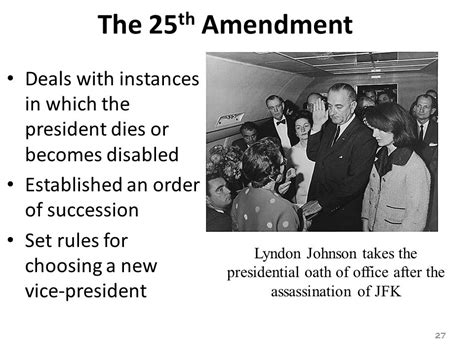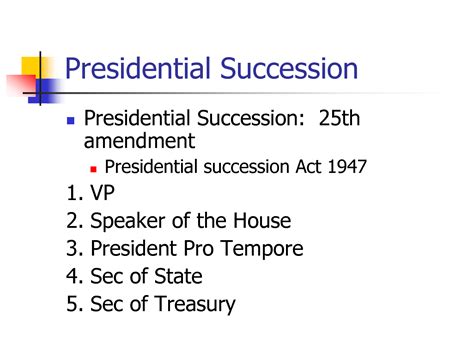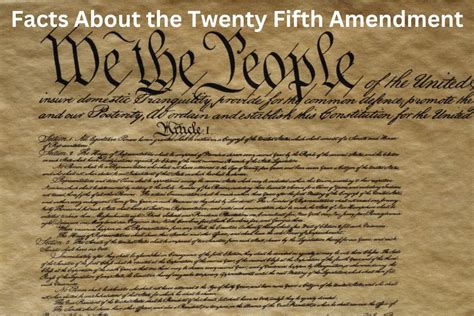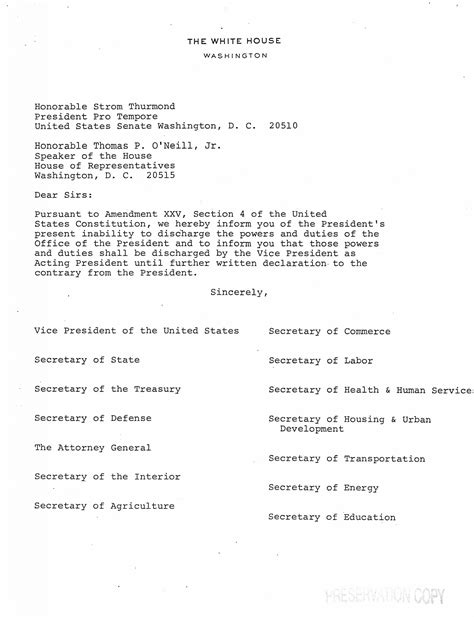
Overview of the 25th Amendment
The 25th Amendment, ratified in 1967, serves as a crucial framework for presidential succession and clarifying procedures during instances of presidential incapacity. This amendment addresses unforeseen circumstances that may hinder a president from fulfilling their duties, thus ensuring the continuity of governance. Notably, Sections 1 and 2 outline the process for a president to be succeeded by the vice president when necessary. “The Constitution should provide methods for filling vacancies in government to maintain public faith,” highlights the importance of preparedness in leadership transitions. Moreover, the amendment includes provisions for temporarily transferring power from the president during periods of disability, reflecting an adaptive governance approach to unforeseen events. Those interested in a more detailed exploration can review external resources such as the GPO Documentor insights from the Reagan Library, which further elaborate on its implications and historical context.

Presidential Succession Process
The Presidential Succession Process, as outlined in the 25th Amendment, provides a structured approach to addressing scenarios in which the president is unable to fulfill their duties. This can occur due to various reasons such as incapacitation or resignation. The amendment establishes a clear line of succession, beginning with the vice president, followed by the speaker of the house and other high-ranking officials. This ensures that there is no power vacuum, which could impede effective governance. Additionally, the amendment allows for temporary transfer of power. For instance, if a president requires medical procedures that render them incapable for a short period, they can voluntarily transfer their powers to the vice president. Understanding these processes is crucial for maintaining governance continuity amidst unforeseen circumstances. For further details on this essential amendment, refer to Wikipediaand Congress.gov.
Filling Vice Presidential Vacancies
When a vacancy arises in the office of the Vice President, the 25th Amendment provides a clear procedure for filling it. This process, outlined in Section 2 of the amendment, allows the President to nominate a successor who must then be confirmed by a majority vote in both Houses of Congress. This ensures that the Vice Presidency does not remain unfilled for an extended period, which is crucial for maintaining effective governance. Notably, this procedure was first put into practice when Gerald Ford was nominated to replace Spiro Agnew in 1973 after Agnew resigned. The importance of this process lies not just in filling the role but also in preserving the presidential line of succession and enhancing overall government stability. For an extensive understanding of the context and implications of this section, further details can be explored hereand here.

Temporary Power Transfer Procedures
The 25th Amendment outlines specific procedures for the temporary transfer of presidential powers when the president is unable to fulfill their duties. In such instances, the president can voluntarily transfer power to the vice president by providing a written declaration to Congress. This ensures that governance remains stable during periods of temporary incapacitation. Additionally, if the president is unable to communicate their condition, the vice president and a majority of the Cabinet can invoke this transfer by submitting a written declaration to Congress. This process protects the continuity of leadership and prevents any power vacuums during critical times. Understanding these procedures helps clarify how governance can successfully navigate emergencies while adhering to constitutional protocols. For further details on this amendment, refer to the Constitution Centerand Ford Library Museum.
Impact on Governance Continuity
The 25th Amendment plays a crucial role in ensuring governance continuity during times of presidential incapacity or vacancy. By clearly defining the procedures for succession, it minimizes confusion during transitions of power. For instance, when the President is unable to perform their duties, the Vice President assumes control, thereby maintaining stability and public confidence in the executive branch.
The amendment also outlines how to fill a vice presidential vacancy, which is vital for preserving a full leadership team. In doing so, it prevents potential power vacuums and allows for more effective governance during uncertain times. The procedural clarity provided by the 25th Amendment supports government functionality and public trust by ensuring that there is always a capable leader ready to step in.
| Situation | Action Taken |
|---|---|
| Presidential incapacity | Vice President assumes duties |
| Vice Presidential vacancy | President nominates a replacement |
For more details on the processes outlined in this amendment, you can visit National Archivesor check out the FAQs at Bipartisan Policy Center.
Historical Applications of the Amendment
The 25th Amendment has been invoked several times in U.S. history, notably addressing both presidential succession and the transfer of power during periods of incapacity. One significant instance occurred in 1985 when President Ronald Reagan underwent surgery, temporarily transferring his powers to Vice President George H.W. Bush. This transfer was executed smoothly, highlighting the amendment’s efficacy in maintaining governance continuity during unforeseen circumstances. Another key application occurred in 1973 when Vice President Spiro Agnew resigned, prompting President Nixon to nominate Gerald Ford as his successor in accordance with the amendment’s provisions for filling vice presidential vacancies. These historical examples illustrate the practical importance of the 25th Amendment in ensuring that leadership is maintained without interruption, establishing a framework that politicians can rely upon in times of crisis. The amendment serves as a vital tool for voters and leaders alike, reaffirming confidence in the stability and continuity of government operations.
Key Terms in Presidential Succession
To fully grasp the intricacies of presidential succession, it is essential to familiarize oneself with several key terms. Firstly, "presidential disability" refers to situations where a sitting president is unable to perform their duties due to mental or physical incapacitation. Understanding this term is crucial, as it forms the basis for determining when the 25th Amendment can be enacted. Another significant term is "acting president," which denotes an individual temporarily assuming the president’s functions—most commonly during a transfer of power. Additionally, "vice presidential vacancy" emerges when a vice president has left office and requires a successor. This vacancy triggers specific procedures as outlined in the Amendment. Highlighting these definitions not only clarifies the discussions surrounding presidential transitions but also emphasizes the importance of having precise terminology to navigate potential crises in governance effectively. Each of these terms plays a vital role in maintaining clarity and continuity within the United States government structure.

Understanding Incapacitation Levels
Incapacitation levels refer to the varying degrees of a president’s ability to perform official duties due to physical or mental health issues. The 25th Amendment provides a framework for determining when a president is unable to fulfill their responsibilities. This may include situations where the president is temporarily incapacitated, such as undergoing surgery or facing severe illness. In these cases, the president may voluntarily transfer power to the vice president, ensuring continuity in leadership. Additionally, if there are concerns regarding a president’s capacity, the vice president and a majority of the Cabinet can declare the president unfit for duty. This process underscores the importance of clear communication and protocols among government officials, emphasizing that decisions about leadership continuity are anchored in established procedures rather than speculation or ambiguity. The amendment thus plays a crucial role in maintaining stability within the executive branch during challenging circumstances.
